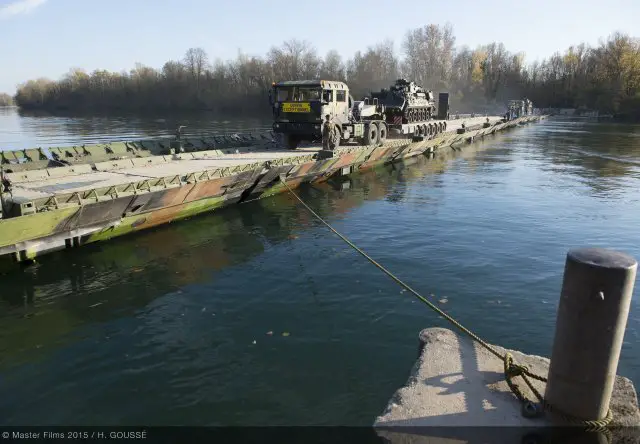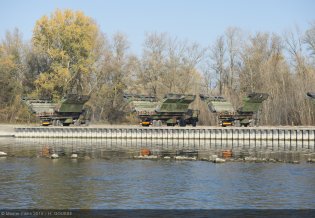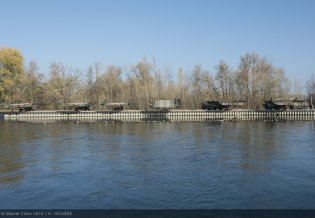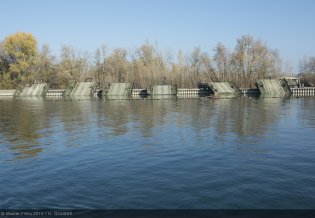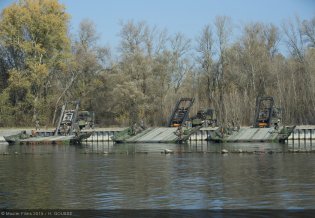| Bridge |
|
The PFM is a solution dedicated to continuous or discontinuous crossing of wet gaps for MLC 70 class vehicles (according to STANAG 2021 standards). It is a robust and reliable system, with the highest operational capabilities. Each section includes two outboard engines, making the system perfectly autonomous on water. The system does not require support from any tugboats.
|
Design
|
|
The PFM offers a certain tactical advantage: it can be easily deployed in record time (13' for a 100m long bridge) with a minimum number of personnel and without auxiliary equipment. Based on a rugged design, it is reliable on the field and requires very little maintenance. The Motorized Floating Bridge offers exceptional adaptability to banks up to a height of 1.80m, without the need for reconfiguration (natural bank adaptability). The PFM is composed of two main parts: the floating modules and the end ramps. There is no restriction on the number of assembled modules.
The floating module has a length of 10 m, a total width of 10.20 m, a track width of 4 m and a height of 1.3 m. It basically consists of a central box, two side boxes and two ballasts.
The ramp is an element of the PFM ensuring the continuity of passage between the bank and the floating module. Each ramp has a 4-meters wide track and has a length of 12.5 m in its bigger version (3.5m length in the smallest variant). The ramp module is equipped with wheel spacers and railings. The end ramps are equipped with a stand-alone hydraulic device for rapid adaptation to banks up to 3 m high.
|
| Mobility |
|
The PFM has excellent mobility: the vehicles transporting the bridge modules are suited to work in difficult terrain (sand, mud). The PFM is deployable on all means of transport (roads, railways, maritime or by air), ensuring rapid intervention in case of crisis. The bridge modules are autonomous and motorized. They can be assembled easily and quickly owing to 360° maneuverability. Each section can be deployed by a reduced staff of four people and doesn't need any erection boat.
Each 10 meters-long module is powered by two Yamaha 3-cylinders engines, developing a power of 75 hp each (55,2 Kw) and has 360° orientation capability.
The ramp section is powered by a single Bernard BM07-11/1520 mono-cylinder engine, developing a power of 3 hp (2.2 Kw).
|
| Accessories |
|
CNIM has designed and improved a new development of the PFM, by installing a remote control for the engines, allowing a halving in the number of crew assigned to maneuvring.
|
| Combat use |
|
CNIM's Motorized Floating Bridge system can be used as a bridge as well as an autonomous ferry, and is characterized by very great ease of use. No preparation of the banks (which can be up to 3 meters high) is needed for launching the sections in the water or for crossing of the vehicles.
Built in a record time of 13 minutes by a crew of 42, the 100 m long bridge is composed of 9 sections and 2 ramps. It can convoy up to 11 vehicles or 3 MLC 70 vehicles in the same time. The bridges can be adapted to all widths of the gap, thanks to the number of assembled sections. They have a flow capacity of 250 vehicles per hour.
|
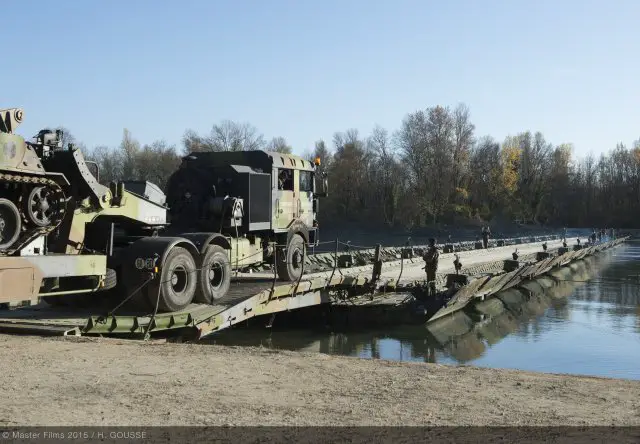 CNIM PFM in bridge configuration CNIM PFM in bridge configuration |
|
The PFM can also be configured as a ferry to ensure discontinuous crossing of wet gaps. Its modularity allows the number of modules to be optimized according to the class and number of vehicles to be transported. 4 floating sections and 2 ramps (PFM 4+2) constitutes a standard long ferry configuration to carry MLC 70 vehicles. Forming a 40 m long ferry, this configuration can be deployed in 20 minutes by crew of 22 soldiers.
On the smallest configurations, compose of only 2 floating sections and 2 ramps (PFM 2+2), the system can carry MLC 40-class vehicles and has a length of 20 meters. It can be deployed in 10 minutes by a crew of 11 soldiers.
Configuring the PFM as a ferry reduces the number of modules implemented, thereby optimizing the number of operators and accelerating the gap crossing operation.
|
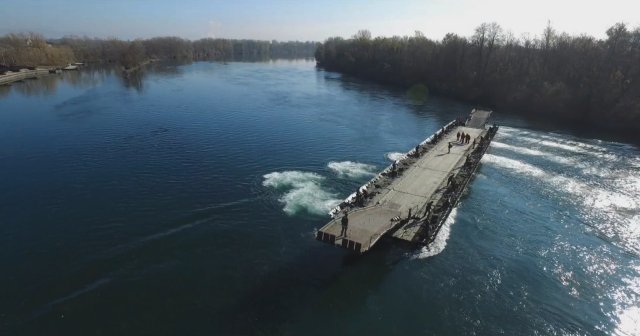 CNIM PFM in ferry configuration CNIM PFM in ferry configuration |
| The PFM by CNIM is currently in service with several armed forces throughout the world, including the French Army. As a response to disaster reliefs, the PFM can also support civil authorities. |
| |
| Specifications |
| Back to top |
|
Armament
|
|
No armament
|
|
Country users
|
|
France, Italy, Switzerland, Malaysia
|
|
Designer Company
|
|
CNIM (France)
|
|
Accessories
|
|
Remote control system for engines
|
|
Crew (section)
|
|
4
|
|
|
Armor
|
|
No armor
|
|
Weight (section)
|
|
10,500 kg
|
|
Performance
|
|
Up to 250 vehicles / hour
|
|
Payload (section)
|
|
20 tons
|
|
Dimensions (section unfolded)
|
|
Length: 10 m; Width: 10.2 m; Height: 1.3 m
|
|
|
